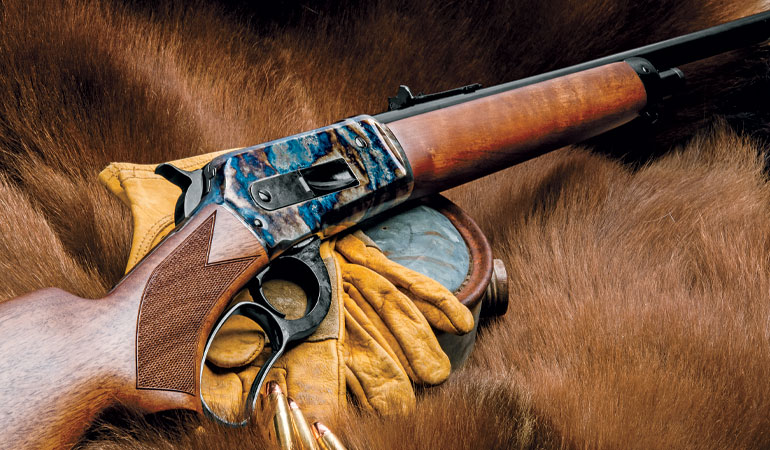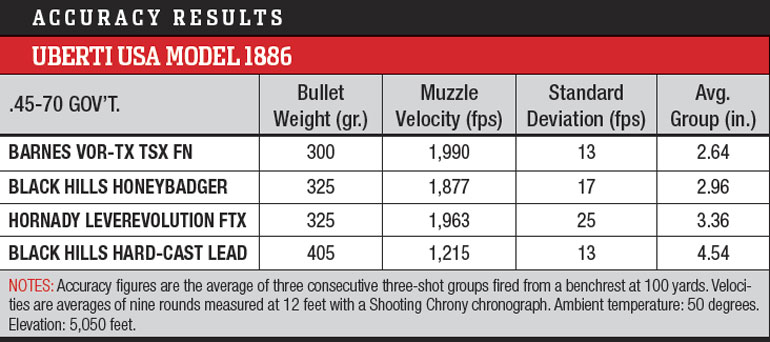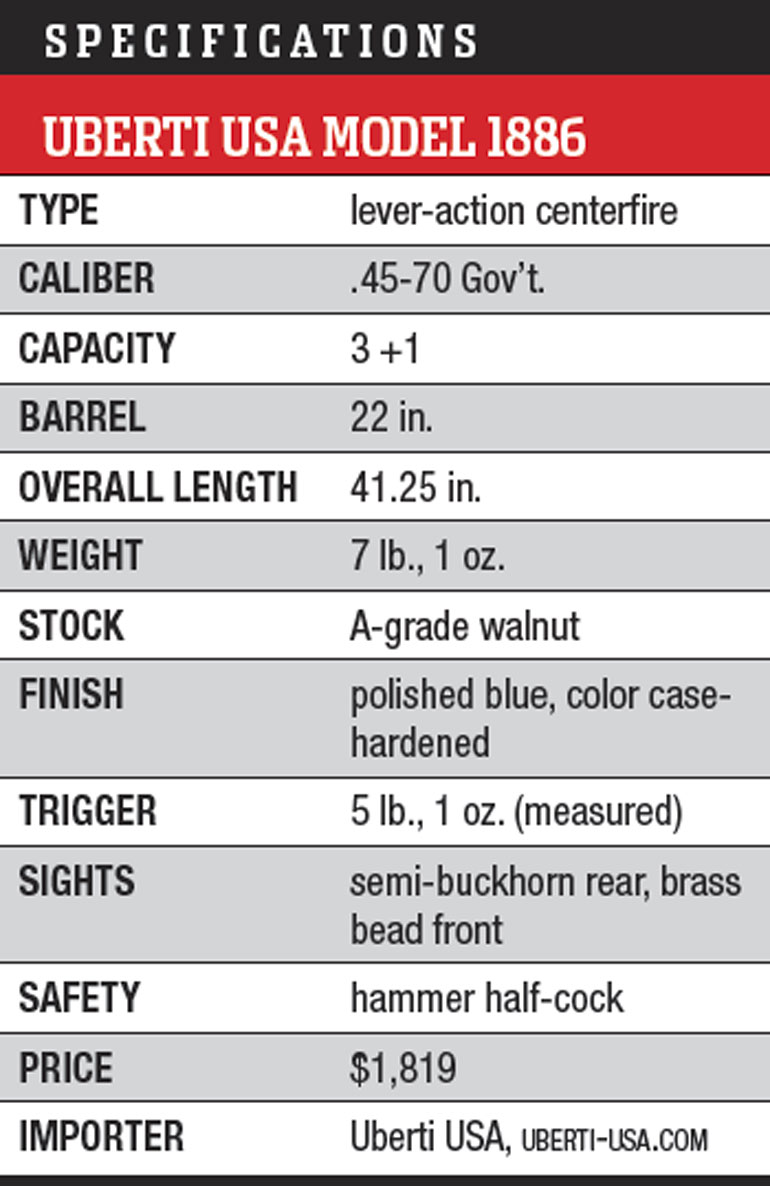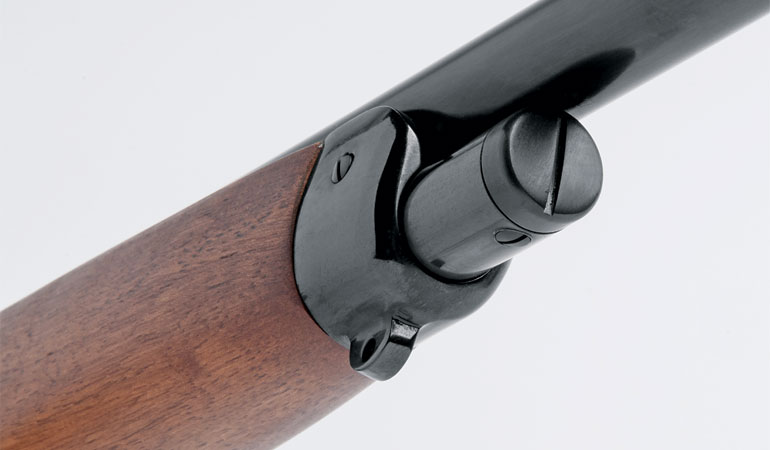
Offering just the right assortment of features, the slick Model 1886 from Uberti provides big-bore lever-gun enthusiasts a new opportunity to own and use an Italian replica of Winchester’s historic hunting rifle.
If you’re not familiar with this gun, Winchester’s lever-action model of 1886 was the first successful rifle to bridge the gap between firepower and authority, effectively pairing high magazine capacity and fast function with authoritative cartridges adequate for potentially dangerous big game. Previously, the great lever guns were limited, for the most part, to revolver-size cartridges, and big-bore cartridges were limited to single-shot rifles. While the 1886 had significantly more recoil than a revolver-caliber lever gun and somewhat less accuracy than a fine single-shot rifle, it did offer unprecedented effectiveness on elk and moose—and even just deer and pronghorns.
As for negotiating dinner plans with a savage, tooth-and-claw-equipped critter with uncivilized intentions, it had no equal. For the first time, North American hunters of big bears had a capable charge-stopping tool.

It was also the earliest lever-action design to effectively make the transition to the smokeless-powder era, courtesy of its strong twin vertical locking blocks. All that was required to withstand the greater pressures of smokeless propellant was a shift to a slightly different steel for the barrel.
Original Model ’86 rifles were chambered in cartridges ranging from .33 W.C.F. to the massive .50-110 Express, but the only round that lives on today is the .45-70 Gov’t. It’s a fantastic all-around rimmed big-bore cartridge, proven for well over a century on all North American big game.
Designed by John Browning, the ’86 features a slightly heavy but sleek action with lovely contours. It’s fed by a tubular magazine affixed below the barrel. A massive, exposed bolt runs fore and aft in the top of the action, and its stout ejector launches empty cartridge cases straight up—so it’s never been a good candidate for a traditional riflescope.
Loading is accomplished via a generous gate in the right side of the action, through which cartridges are thumbed into the magazine. To function the rifle, briskly sweep the lever loop down and forward, then return it to its closed position. This allows a cartridge to slide rearward onto the lifter, and the lifter then pops up like a ramp and presents the cartridge.
The bolt face catches the cartridge rim and pushes it forward into the chamber. Twin locking blocks cam up vertically into their slots, securing the breech.
Although there were a few standardized versions of the 1886, a wide variety of configurations were available by custom order from Winchester. One of the most popular custom combinations paired a shotgun-style buttstock—which transfers recoil much less violently than the more common crescent-type buttplate—with a tapered round barrel and a half-magazine.

The latter resulted in a significantly lighter hunting tool than the standard rifle, and that’s the approach Uberti took with its 1886 Hunter Lite, which features a tapered, round 22-inch barrel and half-magazine, as well as a shotgun-like pistol grip stock. This stock is also found on the Hunter Lite’s bigger brother, a traditional-style 1886 with a 25.5-inch octagon barrel and full-length magazine.
The Hunter Lite version I borrowed for evaluation is nicely blued with a just-past-satin polish on the barrel and hardware. A color case-hardened finish complements the action, and while the vividness and distribution of the color isn’t quite what original Winchester firearms sported, it’s quite attractive.
Two small threaded holes at the left rear side of the action provide a place to mount a receiver-style aperture sight if desired, and the tang is drilled and tapped for a traditional wrist-mounted tang sight. Two extended-length screws for mounting such a sight are included with the rifle.
Being a quite-accurate reproduction, no safety is present on the tang, nor is there a cross-bolt hammer block safety on the rifle.
The barrel is drilled and tapped for a forward-mounted scope base as well. Uberti product manager Tom Leoni said the distance between the holes is 21.8mm, making it compatible with several commercially available bases.
The rear sight is a traditional buckhorn type dovetailed into the barrel, and the front sight features a nice, crisp brass bead on a ramp, which is fixed to the barrel via two screws. Each side of the ramp is grooved for a sight hood, but none came with this test rifle.
A nicely finished and fit steel cap graces the fore-end tip and features a sling stud machined integral to the cap. The forward end of the magazine tube protrudes about an inch. Leaning toward handiness rather than capacity, the mag tube limits capacity to three rounds of ammo plus one in the chamber.

As for the fore-end itself, it’s fairly well profiled, although it has a slight belly that doesn’t follow the leading lines of either the action or the fore-end tip. It’s made of good, dense walnut, with pores well filled and a nice natural-wood satin finish.
The first beef I found with the rifle is where the fore-end joins the bottom front of the action. The wood-to-metal fit at that particular point is poor, with the metal proud of the wood. Everywhere else the wood is only slightly proud of the metal, which—if they can’t make the two flush—is how it should be.
A simple panel of laser-cut checkering is found on each side of the pistol grip, adding a bit of texture for shooting with wet or sweaty hands. An interesting, attractive reverse-radius contour is cut into the bottom of the pistol grip, and the sling stud is a proper two-screw steel affair inlaid into the toe of the stock rather than just a screwed-in stud.
Like the fore-end, the toe of the stock has a slight belly, but aside from that, the buttstock has attractive lines. It’s also fitted with a good rubber recoil pad, which takes the bite out of the .45-70’s substantial recoil.
Lively Balance
Balance is lively and nicely centered between the hands. As a result, the Hunter Lite is particularly responsive even for a lever action, pointing and swinging beautifully. Being brand new, the action is tight but not sluggish, and it didn’t display any undesirable play or looseness. The trigger is a bit stout—right at five pounds by my Lyman digital trigger scale—but breaks cleanly.
Because the Model 1886 is a reproduction of a classic and might be used in cowboy action competition or similar shooting, I rousted out some of Black Hills Ammunition’s traditional 405-grain hard-cast lead ammo that’s loaded to historic (read slow) muzzle velocities of around 1,200 fps.
And because it’s beautifully configured to serve as a close-range brush-busting big game thumper, I added two of my favorite modern .45-70 hunting loads: Hornady’s 325-grain LeverEvolution ammo with the FlexTip bullet that permits pointed bullets to be used in a tubular magazine and Barnes’s VOR-TX ammo loaded with the 300-grain TSX flatpoint. Both loads offer enough velocity to be 200-yard capable, with a tough, controlled-expansion bullet massive enough to offer decent penetration.

Finally, I included an intriguing brand-new load from Black Hills that features a 325-grain HoneyBadger bullet. It’s a solid copper projectile with an X-shaped tip and deeply scalloped flutes in the ogive.
The flutes act hydraulically on impact, creating massive temporary and permanent wound cavities without any bullet expansion at all. While I haven’t yet used the bullet on game, the HoneyBadger promises to produce massive internal trauma coupled with deep, bone-breaking straight-line penetration.
With appropriate hunting ammunition loaded to stout pressures (the Model 1886 is a strong action), the .45-70 cartridge is comfortably adequate for all North American big game, including the big bears, bison and so forth. However, it’s a low-velocity proposition, and use in the field is best kept to 200 yards or less.
Initially, I wondered if the Uberti 1886 would be a tooth-rattler because of its relatively light weight. I needn’t have worried. Recoil, even with the stouter hunting loads, was almost pleasant.
I rested the Model 1886 over my Sinclair benchrest setup and proceeded to shoot a series of three-shot groups at 100 yards. The mid-March sun was warm on my back and helped make for a crisp sight picture on the eight-inch black bullseyes I’d stapled up.
With the buckhorn rear placed in the second notch in the sight elevator, point of impact was on the money with the hunting loads, striking just at the top of the bead front at 100 yards. The slower cast-bullet load required the sight elevator to be placed in the top notch.
While some of Winchester’s Model 1886 rifles displayed excellent accuracy and pretty much all provided accuracy entirely adequate for the hunting ranges of the day, many weren’t exactly write-home accurate. This test rifle fits among the latter, averaging 100-yard three-shot groups of 3.37 inches.
No doubt that average would have been a bit tighter if it were scoped, I was achieving a really crisp, consistent sight picture, and I don’t think the rifle will do significantly better.
That said, it provided usable hunting-grade accuracy for iron-sight use out to a couple hundred yards, averaging between 2.5- and three-inch groups with Barnes 300-grain TSX FN and Hornady 325-grain FTX.
Feeding was just a bit sticky for the first 20 or 30 rounds, but it smoothed up considerably as the action began to break in. By the end of the day, the Uberti ’86 was running slick and clean like it should.
One small issue plagued me. I used the rear sight elevator to shoot different groups on one target face, raising it a notch after firing each in a series of three groups. The sight body—the part that’s supposed to act like a leaf spring and provide the flex needed to raise and lower it on the elevator—was so stiff I couldn’t adjust the sight by hand, even though I strained until blue in the face attempting to prove I could do it.
Finally, I had to tape up the nose of a flat-face screwdriver and use it to cam up the sight while raising or lowering the elevator. This is not a massive issue, but it’s something you should be aware of. Other Uberti rifles may have more flexible sights, but this particular one would be difficult to adjust in the field.
With accuracy testing accomplished, I moved away from the bench and shot casually, running the 1886 through rapid-fire and various target acquisition exercises and getting a better feel for the rifle. As the old saying goes, pumps and lever actions prefer to be run like you mean it. The Uberti functioned flawlessly when levered with speed.
As mentioned earlier, recoil is smooth and almost comfortable. Putting in a good deal of time practicing with the rifle would be pleasurable, particularly from field-type positions that roll easily with the .45-70’s big, slow kick.
After examining the Uberti Model 1886 minutely, photographing it—which tends to bring out small aesthetic issues—and shooting it fairly extensively, I have only one real gripe with it: the price.
At $1,819 it is about half the price of an original in decent, usable condition, which is fair enough. However, Winchester Repeating Arms offers newly made Model 1886 rifles for as little as $1,340 and high-grade Deluxe versions—with nicer walnut, checkering at wrist and fore-end, and extensive color case-hardening on action, lever, grip cap, fore-end tip, and buttplate—for $1,740.
That’s $80 less than the Italian-made version, and it’s rollmarked with the Winchester name. It is worth pointing out, though, that Winchester’s 1886 rifles are not actually made in the U.S. They’re manufactured in Miroku, Japan, where Browning firearms are made.
That said, you’re likely to find the real-world price of a Uberti Model 1886 to be significantly less than the suggested retail price. If you prefer Italian to Japanese, the Uberti is your ticket to big-bore lever-action happiness.
It’s a well-built, well-configured rifle of historic significance and will serve you well at the range and in the field. Reliable, authoritative and chockful of panache, it’s a reproduction Model 1886 any hunter or shooter would be glad to carry.